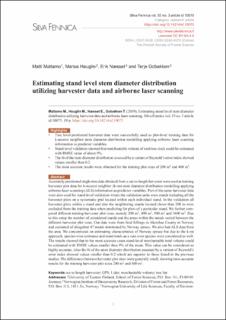| dc.contributor.author | Maltamo, Matti | |
| dc.contributor.author | Hauglin, Marius | |
| dc.contributor.author | Næsset, Erik | |
| dc.contributor.author | Gobakken, Terje | |
| dc.date.accessioned | 2020-10-09T12:38:54Z | |
| dc.date.available | 2020-10-09T12:38:54Z | |
| dc.date.created | 2019-11-04T12:08:32Z | |
| dc.date.issued | 2019 | |
| dc.identifier.citation | Silva Fennica. 2019, 53 (3), . | en_US |
| dc.identifier.uri | https://hdl.handle.net/11250/2682051 | |
| dc.description.abstract | Accurately positioned single-tree data obtained from a cut-to-length harvester were used as training harvester plot data for k-nearest neighbor (k-nn) stem diameter distribution modelling applying airborne laser scanning (ALS) information as predictor variables. Part of the same harvester data were also used for stand-level validation where the validation units were stands including all the harvester plots on a systematic grid located within each individual stand. In the validation all harvester plots within a stand and also the neighboring stands located closer than 200 m were excluded from the training data when predicting for plots of a particular stand. We further compared different training harvester plot sizes, namely 200 m2, 400 m2, 900 m2 and 1600 m2. Due to this setup the number of considered stands and the areas within the stands varied between the different harvester plot sizes. Our data were from final fellings in Akershus County in Norway and consisted of altogether 47 stands dominated by Norway spruce. We also had ALS data from the area. We concentrated on estimating characteristics of Norway spruce but due to the k-nn approach, species-wise estimates and stand totals as a sum over species were considered as well. The results showed that in the most accurate cases stand-level merchantable total volume could be estimated with RMSE values smaller than 9% of the mean. This value can be considered as highly accurate. Also the fit of the stem diameter distribution assessed by a variant of Reynold’s error index showed values smaller than 0.2 which are superior to those found in the previous studies. The differences between harvester plot sizes were generally small, showing most accurate results for the training harvester plot sizes 200 m2 and 400 m2. | en_US |
| dc.language.iso | eng | en_US |
| dc.rights | Navngivelse-DelPåSammeVilkår 4.0 Internasjonal | * |
| dc.rights.uri | http://creativecommons.org/licenses/by-sa/4.0/deed.no | * |
| dc.title | Estimating stand level stem diameter distribution utilizing harvester data and airborne laser scanning | en_US |
| dc.type | Peer reviewed | en_US |
| dc.type | Journal article | en_US |
| dc.description.version | publishedVersion | en_US |
| dc.source.pagenumber | 19 | en_US |
| dc.source.volume | 53 | en_US |
| dc.source.journal | Silva Fennica | en_US |
| dc.source.issue | 3 | en_US |
| dc.identifier.doi | 10.14214/sf.10075 | |
| dc.identifier.cristin | 1743796 | |
| dc.relation.project | Norges forskningsråd: 281140 | en_US |
| dc.relation.project | Norges forskningsråd: 225329 | en_US |
| cristin.unitcode | 192,14,0,0 | |
| cristin.unitname | Miljøvitenskap og naturforvaltning | |
| cristin.ispublished | true | |
| cristin.fulltext | original | |
| cristin.qualitycode | 1 | |

